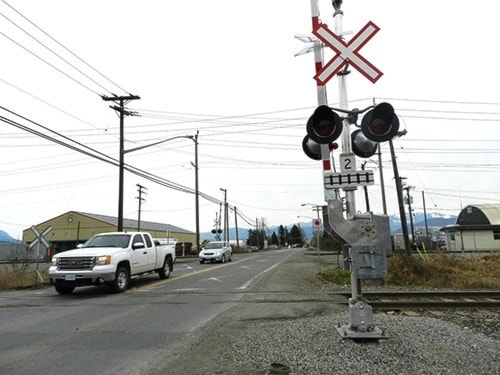Crossing arms have been installed at the railway crossing on Vye Road, addressing an ongoing concern about the safety issues at the site.
The new arms have been in place since Jan. 24, said Katherine Jeffcoatt, director of communications for the city of Abbotsford.
A flag crew had monitored the site since May of last year, after Transport Canada issued an order to the city to maintain a crew until public safety could be ensured. The city received the notice in April of last year, indicating that there was a safety risk at the site due to excessive road traffic, ineffective traffic control and vehicles ignoring the posted stop signs.
Former city manager Frank Pizutto told The News last year that flagging crews cost the city $500 per day. The crews were in place Monday to Friday from 8 a.m. to 4 p.m.
The railway crossing in 2011 was called one of the most dangerous in Canada by a railway safety manager with the B.C. Safety Authority.
The city has previously discussed the possibility of improving the road. A proposed overpass was on the city's list of priority projects for years, but funding has never become available. Jeffcoatt said the city recently met with the provincial government to further discuss the possibility of improving Vye Road and Highway 11.
The cost of installing the crossing arms was an estimated $265,000, which will be paid for by a combination of the city and Canadian Pacific Railways.
Jeffcoatt said the city has received positive feedback from residents who feel that traffic is now moving more freely at the Vye Road crossing with the arms in place.
Eric Samuelson, a railway safety manager with the B.C. Safety Authority, had previously expressed concern about the site's safety to city council. He said with the addition of the arms, safety for the public and the railway workers at the site has greatly increased.
"I think it's a really positive step."
He said his only remaining concern is for public familiarity with the new installation. He said drivers need to be aware of how to abide by the crossing protocol.
Const. Ian MacDonald, spokesperson for the Abbotsford Police Department, said police have been monitoring the site following the installation of the arms. He said that police have issued tickets to drivers who failed to stop for the signal lights and tried to beat the descending crossing arms.
"If someone is going to make the poor decision to go around those railway arms and if we're out there, we're going write them a ticket."
MacDonald said the new arms should be more effective than the old stop signs, and should pose no issue to drivers, as they are the same as the railway crossings at Gladys Avenue and George Ferguson Way.
"By having those arms come down, it's a lot better, in my opinion, to have a visual reminder to people that they can't proceed."
